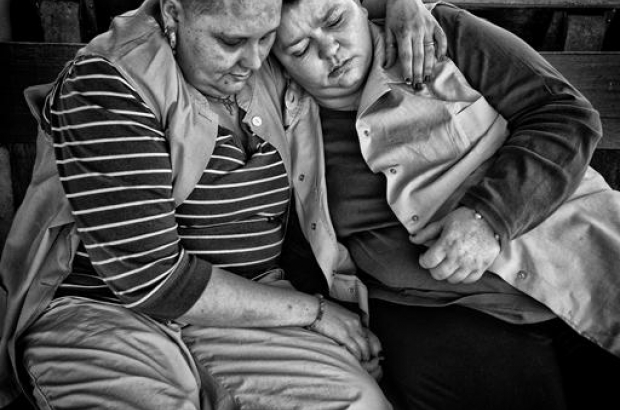- Daily & Weekly newsletters
- Buy & download The Bulletin
- Comment on our articles
Photo project explores everyday Belgian life in black and white
Belgian photographer Cédric Gerbehaye has spent most of his career documenting civil strife and war in Congo, the Middle East and South Sudan. But in his latest project, D'entre eux, he came home to reveal his countrymen and women as they live their lives shaken by political and economic crises. In 21st century Europe, what does it mean to be "at home"? The black-and-white photos were taken during the period 2012 to 2015 and are on display in Mons until 31 January.
Can you tell us a bit about your creative process?
I start with my research, what interests me, and then all the time it takes to get in contact with the people, to get a relationship of trust. Patience is the jewel in the crown of wisdom. That's very important. Patience is also very present in the post-production process.
In the beginning of the project, the work was made with negatives, I was still shooting with film, it's analogue. Then I switched to digital. Even if the file is digital it's been processed as if it's a negative - it's black and white, very classical photography, it's full of contrast, it's grainy because life is grainy. The thing is, when you have a digital file, it's very neutral, but the process I'm using, I try to have a grain that looks like the grain of film.
As soon as it's part of a narration, you have to ask how will it work, how will it fit with an image that goes before and after. You won't have the same result if the image is alone on the wall or if it fits with another one.
You've been a photojournalist for 12 years. Why did you decide to focus on Belgium for this latest project?
I'm Belgian, I was born in Brussels. But I know nothing about my country. This was a real inquiry into what my country looked like. 2012-2015 was a moment of a crisis on a political level, a social level, a financial level. I wanted to explore that specific moment.
Your photos are nominally about events - but are they really about people?
If I go to a carnival for instance, the carnival itself does not interest me. If everybody's photographing it, why should I do it? When I'm at the carnival I try to catch things that tell me something that goes beyond the carnival. What interests me is the gathering of the people, the fact that it's a ritual. What interests me is what happens between people, it's the human condition.
You always need luck with photography. But with time you get an ability to see things. To photograph is to learn how to look at things. I'm interested in things that tell us about who we are and what we are facing.
The work is the result of choices. Where am I going to photograph? Within that community or event, what am I going to photograph? Then I come back and look at the contact sheets and the files on the computer, the pictures I like. Afterward I have to make sacrifices, I leave images on the side. That's the most important.
Do you have a favourite photo?
I like the image of the two women in prison (above) for what it represents and the symbolism of it. I had been sitting next to them and they totally forgot about my presence. They are outside, enjoying the sun for one hour, breathing a bit. There is something about that intimacy. I was able to take a photo very close to them and make a portrait of that couple in a very intimate moment.
You managed to photograph in prisons and other such normally forbidden places. How do you get that sort of access?
By being frank, honest and straight with people. I always explain what I want to do and why I want to do it. I explain as much as I can. Of course some people step backwards and they say: we don't want to have the presence of a photographer here.
For me, the work doesn't stop when I take the photograph. A book and exhibition doesn't work by itself. You need to explain, you need to show. I went to answer children's questions at a school - this is important, this is how I feel you can judge the work of a photographer - what he's doing for people to get a better understanding of the world we're living in.
If I'm engaged at a specific moment in a situation I am very thankful for the people who accept me in that intimacy. Then I have a responsibility to make other people understand what they are living.
D'entre eux, by Cédric Gerbehaye, until 31 January at the Salle Saint-Georges, Grand-Place, 7000 Mons. Open Tuesday-Friday 12.00-18.00, Saturday-Sunday 14.00-22.00. Entry €1/€2. www.mons2015.eu
Photo courtesy Cédric Gerbehaye









